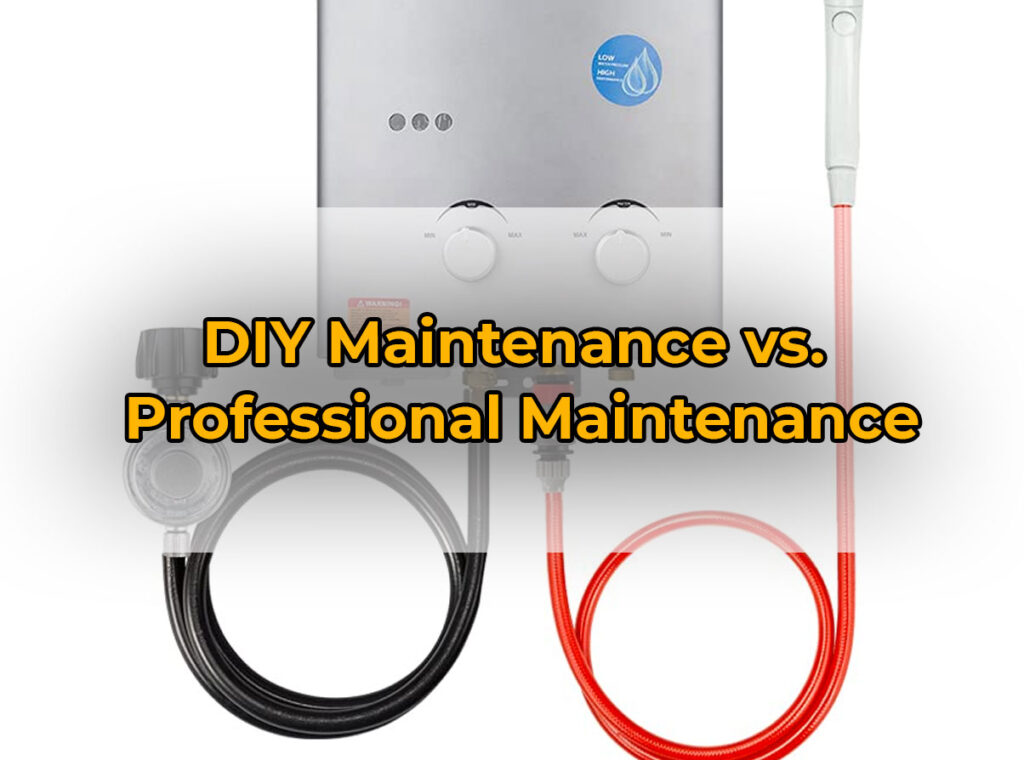Doing the right maintenance to your tankless water heater will make it last longer and save you money. Consider using a water softener or descaler to stop mineral buildup, buying service from certified pros yearly, and keeping a lookout for signs like discolored or strange-smelling water on your bathroom.
By doing these steps, you will make your tankless water heater more efficient and keep it running correctly for years. Just remember: no effort, no reward; but also, no electric shocks, please.
Tankless Water Heater Maintenance Importance

Best Tankless water heaters need regular care to work right and be effective. Here are some important tasks to put in your Tankless Water Heater Maintenance Plan:
- Flush your water heater every year. Without this, mineral buildup can happen, reducing the heater’s efficiency.
- Clean the inlet filter every month. Blocked filters limit air flow and can cause bad performance or harm.
- Check for leaks often. Even small leaks can cause big trouble if left untreated.
It is important to note that maintenance needs may differ depending on where you live, how you use it, and the type of Tankless Water Heater you have.
1. Important Precautions to Take
To ensure your tankless water heater is functioning at optimal efficiency, take these important precautions, such as turning off power and gas supply, and flushing the system. Check Tankless Water Heater Vs Tank for comparing the features.
These measures can help reduce the risk of damage and prolong the lifespan of your unit.
1. Turning off Power and Gas Supply
Securing your property? You must switch off all utilities. Here are four key points to consider:
- Locate the main circuit breaker and switch it off
- Rotate the main gas valve clockwise to turn it off
- If unsure, contact your utility company or a licensed pro for help
- Make sure everyone and pets leave the property before turning off utilities
Different regions have their own protocols for shutting off utilities during emergencies. It caused lots of damage and hurt people. Taking precautions can stop this happening!
2. Flushing the System
System cleaning is essential for keeping your system efficient and long-lasting. It saves time and money! Here’s how:
- Switch off, unplug your device.
- Carefully open and use compressed air to blow away dust and debris.
- Set up a maintenance schedule.
Change worn-out parts immediately to prevent further harm and increase water pressure in shower.
A business owner in Sydney neglected to replace his computer hardware and suffered financial losses due to data recovery costs. Don’t let that happen to you! Clean your system often and replace essential components in time. Check also: Hot Water Pressure Low But Cold Fine.
Cleaning the water filter may be intimidating but it’s not as bad as a dentist’s bill.
2. Cleaning the Water Filter
To ensure your tankless water heater is functioning optimally, it’s important to clean the water filter. This section on cleaning the water filter with sub-sections on removing and cleaning the filter, and replacing the filter, will help you keep your heater in top condition.
1. Removing and Cleaning the Filter
When it comes to keeping your water filter in top condition, there are three steps to take:
- Firstly, shut off the water heater pressure relief valve that supplying water to the filter unit.
- Secondly, carefully disconnect any caps or housings holding the filter in place.
- Thirdly, remove the cartridge and rinse away any debris. Scrub with warm, soapy water.
Check for any signs of damage while you clean, make sure your its clean without water heater sounds like a tea kettle .
Remember, it’s best to change your filter every six months. So, get ready to say hello to a new one!
2. Replacing the Filter
When it comes to keeping your water filtration system in good shape, you should switch the filter out regularly. Here’s how to get it done quickly and safely:
- Shut the water off and unplug the system.
- Find the filter housing and take off the lid/cover.
- Take out the old filter and throw it away correctly.
- Slide the new filter into the housing.
- Put the lid/cover back on and make sure it’s secure.
- Turn the water supply back on and plug in the system.
Remember, the frequency of filter replacement can depend on how much you use it. For instance, a busy house may need to switch out their filter more often than one with less traffic. Also, make sure to get a replacement filter that’s compatible with your setup for the best performance.
3. Checking for Leaks
To check for leaks in your tankless water heater and prevent any damage to the unit, you need to inspect pipes and connections and address any leaks you find.
1. Inspecting Pipes and Connections
Inspection of plumbing is a must to fixing hot water heater leaking. Visually check pipes and fittings for cracks and corrosion. Ensure all connections are secure and sealed. Analyze washers and gaskets for deterioration and replace them if needed.
Note any water damage or mold around pipes and fixtures. Unblock drain pipes that can lead to leaks. Finally, use a moisture meter to locate hidden leaks.
It’s important to remember that regular inspections help save money in future repairs.
Pro Tip: Document inspection dates and any issues found for future reference. To fix leaks is like playing whack-a-mole – another one pops up when you think the last one is fixed.
2. Addressing Any Leaks
It’s important to detect and fix plumbing leaks early. Here are 4 steps to address them:
- Check for visible signs: Look for wet or damaged spots on walls, ceilings, floors, and fixtures. Use a flashlight to peek in tight spaces and note the location and severity of each leak.
- Shut off the water supply: Turn off the main valve controlling water flow into your home or area. Use a wrench or pliers if needed. Open faucets and drains to drain any residual water.
- Repair or replace faulty components: Depending on the type and extent of leakage, you may need to fix or replace pipes, fittings, valves, seals, etc. Consult a professional or DIY guide if you’re not sure.
- Test for operational integrity: Once you’ve fixed the leaks, turn on the water supply gradually and check if all faucets and fixtures work properly. Monitor your water bill over time to check for any hidden leaks.
Bonus tip: Consider installing leak detection sensors that can alert you via smartphone app.
Fun fact: According to IBHS, more than half of indoor flood insurance claims are due to plumbing failures such as burst pipes and overflowing fixtures.
4. Descaling the Heater
To keep your tankless water heater functioning effectively, descaling is an essential step in its maintenance. With the sub-sections of understanding the importance of descaling, choosing the right descaling solution, and flushing and descaling the system, you can easily perform this task. It will help you to avoid damage to the heater and ensure you have hot water when you need it.
1. Understanding the Importance of Descaling
Calcium and magnesium deposits can build up in water heaters. This can make them run less efficiently and even lead to breakdowns. Descaling is the process of removing these deposits. It helps the heater run at its best and increases its lifespan.
Regular Maintenance of Water Heaters is essential. Mineral buildup can cause damage or clog up the system if it’s neglected. This means they need replacing sooner than those that are regularly maintained.
Also, overused heating elements consume more electricity. Regular maintenance is needed for efficiency and to save money on energy bills. Descale your water heater at least once a year.
Pro Tip: Use white vinegar to clean the tank. Avoid harmful chemicals found in other commercial cleaning products. When it comes to descaling, choose your favorite ‘poison’ – this one won’t kill you!
2. Choosing the Right Descaling Solution
Time to give your heating system a spa day! Flush out those nasty clogs with the perfect descaling solution.
Selecting the right one is key. It should be compatible with your heating system, free from harsh chemicals, efficient, eco-friendly and safe to use. This way, you’ll not only increase the lifespan of your heating system, but also improve its efficiency and air quality.
Remember, it’s essential to choose wisely in order to avoid any future maintenance issues.
3. Flushing and Descaling the System
Flushing and descaling the heater is a must to get rid of sediment and rust build-up. This can help enhance the heating system’s performance. Here is a step-by-step guide for getting rid of these pesky impurities:
- First, turn off the power to the heater for safety.
- Then, drain all water, disconnect all electrical connections, and pull out anode rods. After that, flush water through the unit until it’s crystal clear.
- Use a funnel to add descaler, pour hot water in, let sit for half an hour. Lastly, drain out all water again.
It’s recommended to descale every 1-2 years, depending on how much you use the heater and the hardness of your water supply.
Fun Fact: Consumer Reports conducted a study that showed properly maintaining heaters can extend their life to 12-15 years. DIY maintenance is like playing Operation, except instead of removing a funny bone, you could end up taking out your plumbing!
DIY Maintenance vs. Professional Maintenance

To ensure prolonged and efficient use of your tankless water heater, you need to know the best ways to maintain it. In this section on DIY Maintenance vs. Professional Maintenance for Tankless Water Heaters, you’ll learn about the benefits of professional maintenance and a cost comparison for DIY vs. Professional maintenance.
1. Benefits of Professional Maintenance
Professional Maintenance: Advantages!
Professional maintenance services offer some amazing benefits that DIY maintenance can’t. Here are some of them:
- Expertise and Experience
- Advanced Equipment and Tools
- Efficient and Time-Saving Solutions
- In-depth Inspection and Analysis
- Error-Free Results with Guaranteed Quality
- Cost-Effective Long-term Solutions with Warranties
Plus, you’ll never have to worry about the quality of the work.
To have a hassle-free ownership experience, it’s best to invest in professional maintenance services from trusted providers. This must be combined with regular upkeep by skilled professionals. They have knowledge from years of experience.
Don’t miss out on these advantages! Get ahead now and secure your physical assets’ value later!
DIY can save you money on maintenance. But, if you want to save time, money, and your sanity, professional maintenance is the way to go!
2. Cost Comparison for DIY vs. Professional Maintenance
When comparing DIY vs. professional maintenance costs, it is important to analyze all aspects of both options. Cost Comparison for DIY vs. Professional Maintenance involves weighing the pros and cons, and considering the type and complexity of maintenance required. Check out this table to compare typical costs for basic maintenance tasks:
| Task | DIY Cost | Professional Cost |
|---|---|---|
| Unclogging Drains | $20-$50 | $100-$250 |
| Painting | $200-$500 | $400-$700 |
| Landscaping | $1000-$3000 | $3000-$5000 |
Keep in mind that hiring a professional has added benefits such as quality assurance, guarantee, and timeliness. On the other hand, DIY gives you more control. Homeowners should consider their skills and experience when taking on more complex repairs or renovations.
Consulting with professionals can help determine the best course of action. Pro Tip: DIY usually saves money, but it can cost more time and hassle for inexperienced homeowners. Keep your tankless water heater happy and efficient with regular maintenance – or face its fiery revenge.
Conclusion
Regular maintenance is key for a tankless water heater to work efficiently and last long. Inspect the air inlet filter, descale the heat exchanger and look for leaks or malfunctions. Hire a professional to service it every 1-2 years. Neglecting maintenance can lead to poor performance, higher energy bills and repair costs.
When maintaining your tankless water heater, make sure there’s good airflow around the unit. Don’t put objects on top of it. And use a water softener to avoid mineral buildup in the heat exchanger.
Pro Tip: If you’re having problems after regular maintenance, get a licensed professional to fix it.
“There is no real ending. It’s just the place where you stop the story.”






